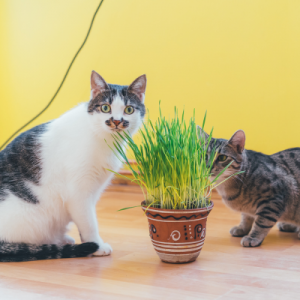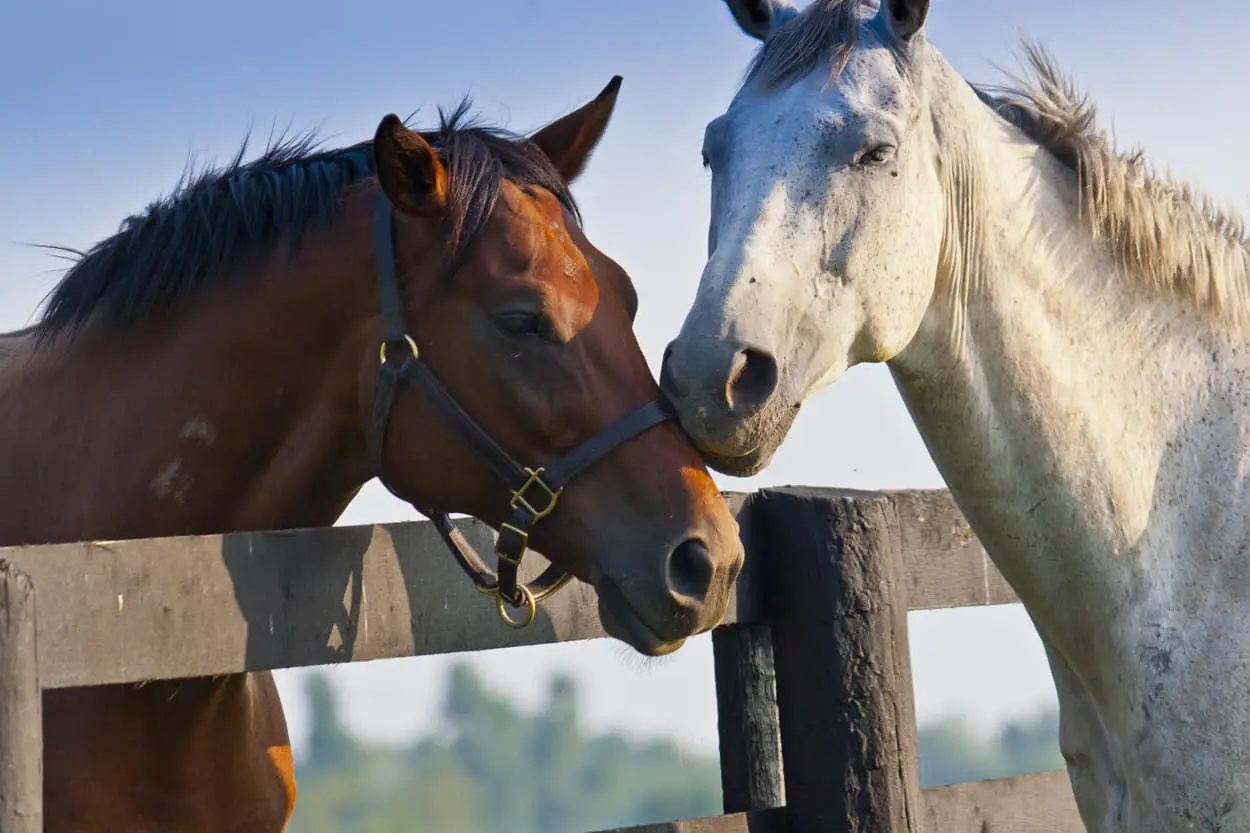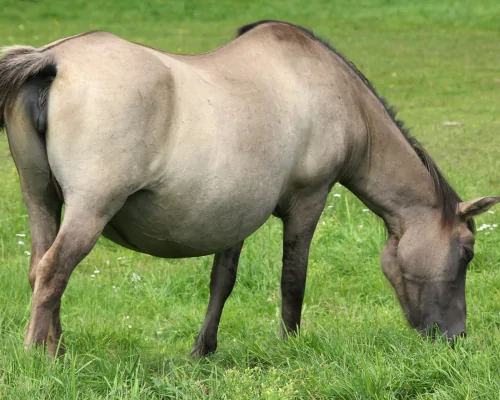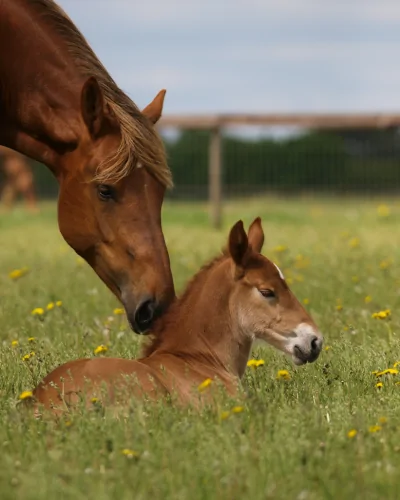
Cat captivated by catnip.
Do you ever wonder why cats love catnip so much? Simple: they, like so many humans, love to enjoy that dizzy, euphoric sensation! But how are you supposed to safely introduce this mystical herb to your precious fur baby?
In this blog, we’ll dive deep into the chemistry and biology of catnip to reveal the secret behind the feline ecstacy. But that’s not all! We’ll also provide a detailed guide on how to recognize when your cat is “high” on catnip, ensuring you can spot the signs of a catnip-fueled adventure.
Of course, as responsible pet parents, we’re always concerned about our cat’s well-being. That’s why we’ve included a comprehensive section on the risk factors and safety considerations of catnip. Also, a bit of expert advice on how to safely give catnip to your furry friend.
So, join us as we unravel the mysteries of this captivating plant and learn how to safely indulge your feline friend in a catnip experience that they’ll never fur-get! (sorry, couldn’t resist that one) Read on to discover the science behind catnip and how to provide a safe, enjoyable experience for your beloved pet.
Facts about giving catnip to cats
- Catnip’s active compound, nepetalactone, triggers a neurological response in cats, causing playfulness, vocalizations, and rolling behavior.
- Risk factors of giving catnip to cats include over-consumption, inter-cat aggression, and allergies. Thus moderation and supervision are essential
- Safely administer catnip by choosing organic catnip, introducing it in moderation, and considering alternative plants for sensitive cats.
The science behind catnip and feline euphoria

Catnip is in the mint family.
Catnip, scientifically known as Nepeta cataria, is a perennial herb belonging to the mint family. Although it is native to Europe and Asia, catnip has been naturalized in North America and is now commonly found in gardens and parks. So, what makes catnip so attractive to our feline friends? The secret lies in its active compound: nepetalactone.
Nepetalactone is a volatile oil that is released when the plant Nepeta cataria is crushed or bruised. It’s this compound that triggers a neurological response in cats, leading to the feline excitement that we observe. When a cat comes into contact with catnip, nepetalactone molecules bind to olfactory receptors in their nasal cavity. These receptors then send signals to the brain, stimulating the release of “feel-good” neurotransmitters like dopamine and serotonin.
Interestingly, not all cats respond to catnip. Research suggests that the sensitivity to catnip is hereditary, with approximately 50-75% of cats exhibiting a response. This genetic variability means that some cats may have a more intense reaction to catnip. Yet, others might be indifferent or even repelled by it. Imagine that: being physically repulsed by a plant that lets you have fun. Talk about a bummer.
So, next time you see Whiskers rolling in a pile of catnip or gleefully batting at a catnip-filled toy. Just remember that the secret to the bliss lies in a fascinating dance between plant chemistry and feline biology.
How to recognize when your cat is “high” on catnip
Let’s get one thing straight: it is hilarious to see cats get high on catnip. Seriously if you’ve never seen it then boy you are in for a treat. But how can you tell if your feline friend is actually feeling it? Here are some common behavioral changes to look for when a cat has gotten into some catnip:
- Playfulness and jubilation: Cats under the influence of catnip may become exceptionally playful, often pouncing on, batting at, or chasing imaginary prey. Their antics can be a source of endless amusement for their pet parents, if not a bit confusing, but remember: it’s all in good fun!
- Vocalizations and purring: You might notice your cat becoming more vocal while enjoying catnip, with increased purring, meowing, or even growling. These sounds can be expressions of delight or excitement as they indulge in their new favorite plant.
- Rolling, rubbing, and drooling: Cats high on catnip often exhibit a desire to rub their bodies against the source of the catnip.They may also roll around on the ground or drool excessively. This behavior helps release more of the nepetalactone, amplifying the sensory experience for your feline friend.
The duration and intensity of the catnip effect can vary among individual cats. Typically, the high lasts for about 10-15 minutes, followed by a refractory period of about 30 minutes to 2 hours. During the refractory period, your cat will not be responsive to catnip, so no double dipping! Factors such as age, breed, and individual temperament may influence how each cat reacts to catnip, with some showing more intense or prolonged responses than others.
The risks of giving your cat catnip

Cat sniffing catnip.
While catnip is generally considered safe for cats, there are a few risk factors and safety considerations that pet parents should be aware of. By keeping these things in mind, cat parents can ensure their feline friends have an enjoyable and risk-free experience while getting high:
- Over-consumption of catnip: Although most cats simply sniff or roll in catnip, some may consume it – like a lot of it. Ingesting large amounts can lead to gastrointestinal issues such as vomiting or diarrhea. Additionally, over-consumption may cause lethargy or agitation in some cats. To avoid this, offer catnip in moderation and monitor your cat’s response.
- Inter-cat aggression: Catnip can sometimes trigger aggression, particularly in multi-cat households. If you notice signs of aggression or tension, separate your cats and provide individual play sessions with catnip to minimize conflict.
- Allergies and sensitivities: Although rare, some cats may have an allergic reaction to catnip or develop sensitivities with repeated exposure. If you notice any signs of an allergic reaction, such as excessive scratching, sneezing, or swelling, hit “paws” on the catnip party and consult your veterinarian.
Above all, it’s important to remember that catnip must be used in moderation. While catnip can be a great way to stimulate your cat’s senses and encourage play, offering it too frequently may cause them discomfort. Limit catnip sessions to once or twice a week and always supervise your cat during playtime to ensure their safety.
How to safely give your cat catnip
Now that you’re familiar with the effects of catnip on your feline companion and the safety considerations, it’s time to learn how to safely administer this delightful treat. Follow these steps to ensure a fun and safe experience for your cat:
- Choose high-quality, organic catnip: Opt for organic catnip from a reputable source to minimize the risk of exposure to pesticides or other harmful substances. This will ensure your cat gets the most potent and safe experience possible while they’re high.
- Introduce catnip slowly: For first-time catnip users, start with a small amount to gauge your cat’s response. Sprinkle just a pinch of dried catnip on a scratching post, a toy, or a designated area on the floor they’re familiar with. Alternatively, you can offer fresh catnip leaves for your cat to sniff and interact with. If they respond positively, now you know how much to give them to elicit a response. In the future, try to stick to this dosage so as to not accidentally desensitize them to its effects.
- Experiment with different forms of catnip: Catnip comes in various forms, including fresh leaves, dried, or infused in toys. Each form has its benefits, with fresh catnip leaves offering the most potent nepetalactone concentration. Dried catnip or catnip-filled toys, on the other hand, can offer a convenient and mess-free alternative to the naturally occurring plant.
- Explore catnip alternatives for cats with sensitivities or no response: If your cat doesn’t respond to catnip or has sensitivities, consider alternatives like silver vine, Tatarian honeysuckle, or valerian root. These plants contain compounds similar to nepetalactone and may elicit a comparable response in cats.

Cat investigating a potted catnip.
By understanding the science behind catnip, recognizing the signs of catnip exposure, and being mindful of its risk factors, you can provide your feline friend with an enjoyable and safe high. Isn’t that what parenting is all about?
After all, your cat’s happiness and health are of the utmost importance, and there’s always more to learn! To stay informed about the latest tips, tricks, and insights on feline care, we invite you to regularly visit Banixx.com. Our website is constantly updated with expert advice on various topics, from cat nutrition and cat grooming to cat behavior and preventative care for cats.
Join our growing community of passionate pet parents at Banixx.com, and together, let’s give our feline friends the best life possible.
Of course, you already know to be cautious when it comes to your pet’s health – otherwise you wouldn’t be reading this blog! That’s why we hope you’ll come back to our blog to learn more about how to keep your four-legged friend happy and healthy. If on the other hand, you are interested in how to maintain your cat’s teeth, we cover that too. Interested in more quirky items such as why cats knock things off tables, yep, we’ve got that covered.
Sources
Crowell-Davis, S. L., & Curtis, T. M. (2016). Feline aggression. In Behavior of Exotic Pets (pp. 181-191). Wiley-Blackwell.
Foster, A., & Johnson, K. (2019). Cat Owner’s Home Veterinary Handbook. Howell Book House.
Share this Post
Featured Post
Recent Posts
Why is my Cat peeing everywhere? all the time? All you need to Know about Feline Idiopathic Cystitis

Do horse coat colors affect their behavior?

Lipomas….mysterious Lumps & Bumps on your pup…When should I worry? What should I do about them?

Managing the Mamas –Part 2 –The Foal development process

Managing the Mamas: Part 1 – Preparing to Breed Your Mare


